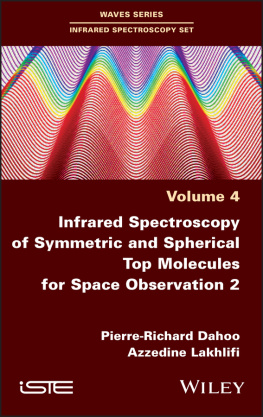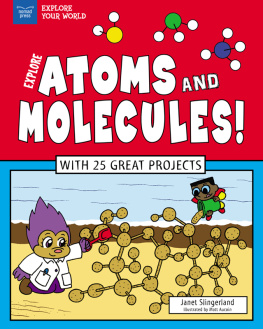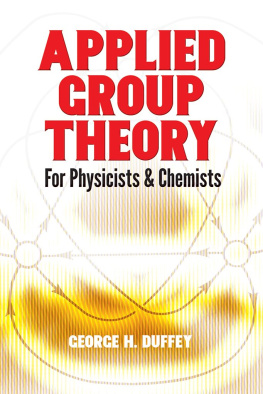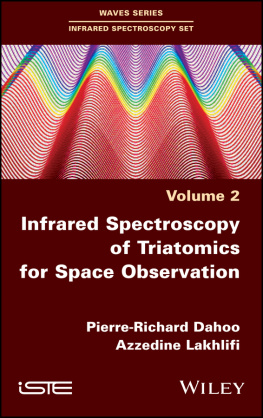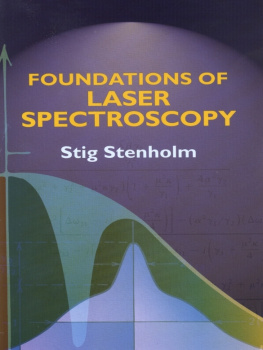Infrared Spectroscopy of Symmetric and Spherical Top Molecules for Space Observation 2
First published 2021 in Great Britain and the United States by ISTE Ltd and John Wiley & Sons, Inc.
Apart from any fair dealing for the purposes of research or private study, or criticism or review, as permitted under the Copyright, Designs and Patents Act 1988, this publication may only be reproduced, stored or transmitted, in any form or by any means, with the prior permission in writing of the publishers, or in the case of reprographic reproduction in accordance with the terms and licenses issued by the CLA. Enquiries concerning reproduction outside these terms should be sent to the publishers at the undermentioned address:
John Wiley & Sons, Inc.
111 River Street
Hoboken, NJ 07030
USA
www.wiley.com
The rights of Pierre Richard Dahoo and Azzedine Lakhlifi to be identified as the authors of this work have been asserted by them in accordance with the Copyright, Designs and Patents Act 1988.
Foreword
Spectroscopy is the high road to physico-chemical measurements of astrophysical objects, such as the interstellar medium, stars or planets and exoplanets. In recent decades, the understanding of the increasingly finer details of the interaction between matter and radiation, as reflected in the spectral range by effects, sometimes unexpected, on the observed spectra, has led to outstanding advances in spectroscopy, from ground- or space-based observations. For this purpose, increasingly sophisticated instruments were developed for space probes, initially inspired by laboratory instruments, in order to cope with the severe constraints of space observation and exploration.
The challenge of laboratory spectroscopy presented in this book, the fourth volume in this series, resides not only in registering increasingly complex spectra, even for the simplest molecules observed at high temperature or excited to high vibrational states, but also in understanding specific molecular mechanisms, such as the spectroscopy of molecules in rare gas matrices, clathrates or physico-chemical mechanisms related to the adsorption on graphite substrates. These mechanisms can be used to extrapolate to the very specific conditions of the interstellar medium, where the very rich chemistry discovered by the observations in the millimetric range in the last 50 years is highly dependent on ionmoleculesubstrate mechanisms.
Spatial instrumentation in remote spectroscopy offers the possibility of exploring planets with atmospheres, particularly by means of instruments with medium to high resolution. However, Earth observations should be treated separately, as they have other objectives, particularly operational ones, and a different approach and constraints compared to the various distant exploration missions, even though they involve similar categories of instruments. Fourier transform spectrometers have measured, in particular, the atmospheres of Mars, Venus and giant planets and their satellites, thanks to their performances in combining large spectral extent and (relatively) high resolution. The pioneering missions were Mariner, Venera and Voyager. Grating or prism spectrometers, particularly those using adjustable prisms (AOTF Acoustic Optic Tunable Filter), have also provided remarkable results on Mars and Venus. After the first observations using variable circular filter spectrophotometry (IKS on Vega probe), comets, with their highly specific atmosphere, were observed with grating spectrometers (VIRTIS on Rosetta), which led to a better understanding of their composition and revealed surprising isotopic ratios.
Substrate spectroscopy issues are connected with planetary studies in order to understand the adsorption chemistry at play in the interstellar medium, as well as in the very high atmosphere of planets: one of the key results of the Cassini mission showed that the complex hydrocarbons observed on Titan were generated not only from the photochemistry of nitrogen or methane atmosphere at the level of high clouds, but also in the ionic chemistry of the very high atmosphere, measured directly using mass spectrometry from the instrument aboard the Cassini during its flight over Titan.
There is no doubt that there is still room for embedded spectroscopy to significantly evolve into future space missions: Raman spectroscopy methods, still fresh on planetary probes (Mars Curiosity and Perseverance missions), LIDAR observations or the CRDS technique will lead the way to new advances, which laboratory techniques and theoretical models will help to interpret. The joint progress of various disciplines of chemistry, spectroscopy and of Earth and universe sciences is a remarkable example of a coordinated multidisciplinary approach that involves the joint research efforts of laboratories of various specializations. This book, the fourth volume in the series Infrared Spectroscopy of Molecules for Space Observation, focuses on the context and results of this research.
Pierre DROSSART
Paris Institute of Astrophysics, CNRS, Sorbonne University
June 2021
Preface
The observable universe is visible thanks to the light that reaches us from the point being observed. These extreme points form the contour of a sphere, whose limit lies at the cosmological horizon, with the Earth at its center. Other observers, located elsewhere in the universe, see a different observable sphere of the same radius. It is a relative notion. Let us recall that in cosmology, the unit of measurement for distances is the light-year, which is the distance that light travels in one year, which corresponds to about 9.5 1012 km. The megaparsec, which amounts to 3.26 million (3.26 106) light-years, is another unit of distance used particularly in extragalactic astrophysics. The Standard Model of Cosmology elaborated at the beginning of this century, by 2000, is perhaps the most successful model presently that offers a description of the evolution of the universe, in terms of the major stages in the history of the observable universe, as well as its current composition resulting from astronomers observations. In order to explain the myriad of observable galaxies and planetary systems, suns and black holes, cosmologists proposed an inflationary model.
As mentioned in the prefaces of the previous volumes, the universe is a preferred spatial environment for astrophysicists, cosmologists, astronomers and physicists, both for observations and for testing the theory of general relativity of Albert Einstein by means of predicted and observed phenomena, elaboration of new theories and their expected confirmation by observations. This is the context in which the Nobel Prize for Physics was awarded to Sir Roger Penrose in 2020, for his work on the existence of black holes based on the theory of general relativity, and to astronomers Andrea Ghez and Reinhard Genzel, for their research on the phenomena observed at the center of the Milky Way galaxy in the Sagittarius A region, where the existence of a black hole was predicted, and who showed that, indeed, a supermassive black hole was present there.

